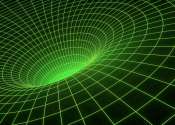Research concludes there is no 'simple theory of everything' inside the enigmatic E8
The "exceptionally simple theory of everything," proposed by a surfing physicist in 2007, does not hold water, says Emory University mathematician Skip Garibaldi.
The "exceptionally simple theory of everything," proposed by a surfing physicist in 2007, does not hold water, says Emory University mathematician Skip Garibaldi.
General Physics
Mar 26, 2010
19
0

(PhysOrg.com) -- A group of astronomers, led by Tim Schrabback of the Leiden Observatory, conducted an intensive study of over 446 000 galaxies within the COSMOS field, the result of the largest survey ever conducted with ...
Astronomy
Mar 25, 2010
2
0

(PhysOrg.com) -- Black holes are my constant companions, at least in my imagination. Starting back a couple of decades ago, two sets of basketball tickets disappeared into one of them, and since then a pair of ski gloves, ...
(PhysOrg.com) -- A team of physicists from the University of Glasgow has predicted the mass of a new particle which would help explain one of the fundamental forces of the universe.
General Physics
Jan 26, 2010
17
0

(PhysOrg.com) -- Scientists have a long and unsuccessful history of attempting to convert hydrogen to a metal by squeezing it under incredibly high and steady pressures.
Superconductivity
Oct 5, 2009
5
0

(PhysOrg.com) -- Black holes are invading stars, providing a radical explanation to bright flashes in the universe that are one of the biggest mysteries in astronomy today.
Astronomy
Sep 18, 2009
12
0

(PhysOrg.com) -- Theorists have long wondered how massive stars--up to 120 times the mass of the Sun--can form without blowing away the clouds of gas and dust that feed their growth. But the problem turns out to be less mysterious ...
Astronomy
Jan 15, 2009
0
0

What is dark matter? Even for astrophysicists, it's a question that remains unanswered. These invisible particles make up most of the matter in the universe and about a quarter of the universe as a whole. They are thought ...
Astronomy
Jul 24, 2024
0
46

Dark matter is a hypothetical form of matter that is implied by gravitational effects that can't be explained by general relativity unless more matter is present in the universe than can be seen. It remains virtually as mysterious ...
Astronomy
Jun 7, 2024
134
2517

Few things in nature are as predictable as ocean tides. Driven by the moon's and sun's gravitational pull, these persistent, short-period, and large-magnitude phenomena are apparent in nearly all types of oceanographic and ...
Earth Sciences
May 20, 2024
0
835